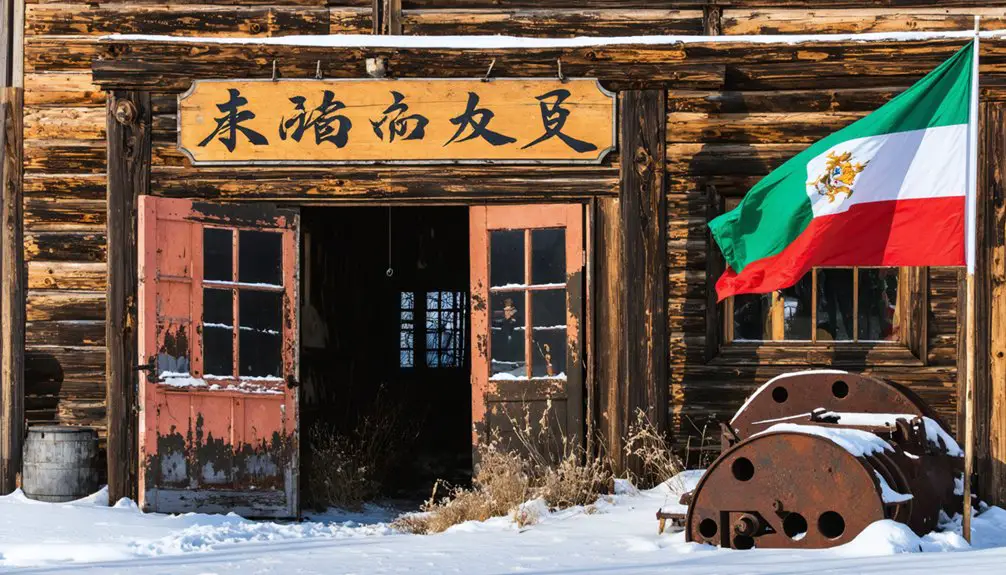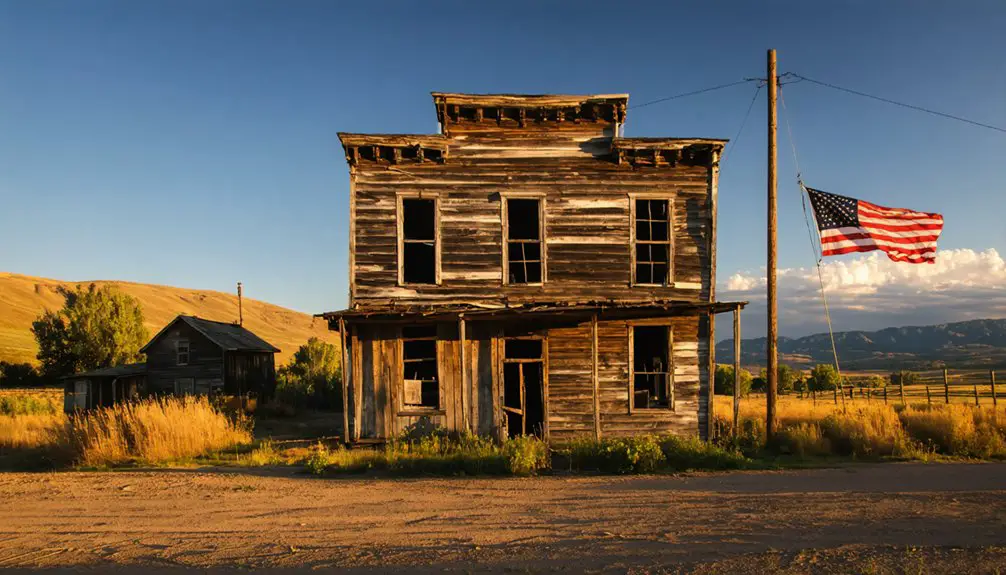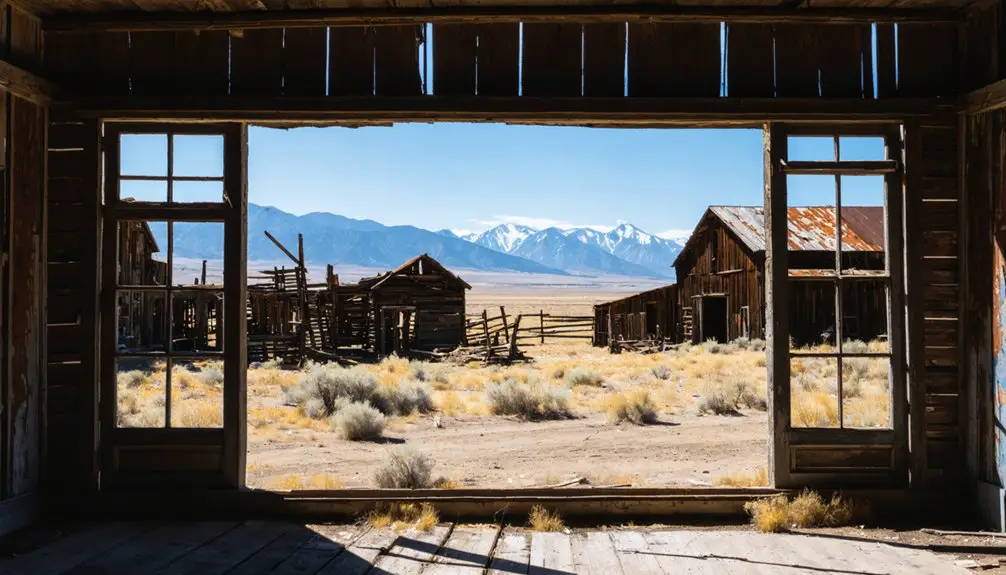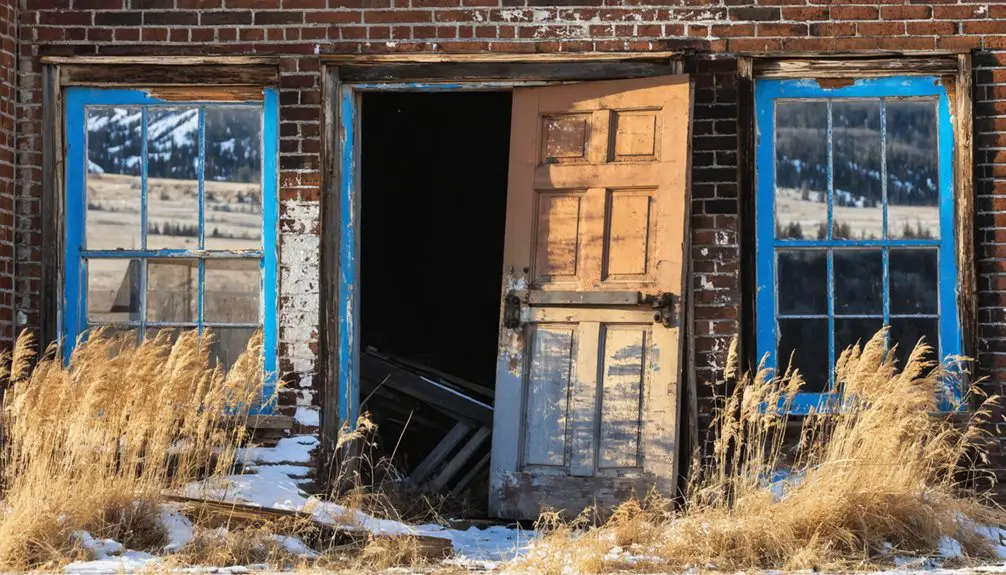You’ll find Silver Bow’s origins in Montana’s 1864 gold rush, when prospectors named it after the creek’s shimmering curves at sunset. The settlement quickly grew from placer mining to sophisticated underground operations, boosted by the arrival of railroads in the 1880s. While diverse immigrant communities created vibrant neighborhoods like Dublin Gulch, the town eventually declined as mining operations ceased. Silver Bow’s story captures the dramatic rise and fall of America’s western mining frontier.
Key Takeaways
- Silver Bow originated as a thriving mining settlement in 1864 after gold discoveries in Silver Bow Creek sparked Montana’s mining boom.
- The town flourished during the 1880s with railroad expansion and mining infrastructure, supporting diverse immigrant communities from Europe and Asia.
- Mining operations shifted from placer gold to underground copper and silver extraction, supported by extensive smelting facilities.
- Historic neighborhoods like Dublin Gulch and Meaderville represent the cultural legacy of immigrant miners who shaped the community.
- Silver Bow declined as mining operations ceased, leaving behind industrial remnants and abandoned structures as testament to its prosperous past.
The Origin Behind Silver Bow’s Name

While Silver Bow Creek‘s winding path through Montana’s landscape provided the inspiration for its name, the creek’s shimmering waters at sunset ultimately sealed its linguistic fate.
When early prospectors witnessed the light dancing across the water’s surface, they marveled at the “pretty silver bows,” cementing the creek’s enduring name.
Before European settlers arrived, the Salish people knew this waterway as “Sin-tahp-kay,” recognizing its abundance of bull trout and natural resources.
The Salish recognized Silver Bow Creek’s bounty long before settlers arrived, honoring its waters with their name Sin-tahp-kay.
The creek’s cultural significance extends beyond its namesake, as it became the heart of Montana’s mining heritage. Gold discoveries in the creek beds in 1860s sparked the initial settlement of the area.
You’ll find that Silver Bow’s rich history intertwines with the settlement of Butte City, which would later become simply Butte, while the county retained the poetic Silver Bow name.
Early Days of the Mining Camp
When Bud Barker, Frank Ruff, Pete Slater, and their fellow prospectors discovered gold along Silver Bow Creek in 1864, they sparked western Montana’s first major mining rush. Within months, nearly 1,000 miners descended upon the creek, employing placer mining techniques to extract the precious metal.
You’ll find that this initial gold boom didn’t last long. As placer deposits quickly depleted, miners shifted to underground quartz mining for silver, gold, and copper. A quartz mill and smelter were built to process the ore, but the operation was ultimately abandoned.
The first mills appeared along Silver Bow Creek in 1868, though their discharge of tailings began affecting the environment. The industry’s growth accelerated when the Union Pacific Railroad reached Corrine, Utah, lowering supply costs and enabling ore shipment.
Mining entrepreneur W.A. Clark even shipped ore as far as Baltimore for processing, demonstrating the camp’s expanding reach and ambition.
Railroad’s Impact on Mining Development

You’ll find that the arrival of the Utah & Northern Railway in 1881 transformed Silver Bow’s mining prospects by dramatically reducing transportation costs and enabling year-round shipments of machinery and ore.
The reliable rail access attracted substantial trans-Atlantic capital investment, with investors now confident in the district’s ability to efficiently export metals to distant markets. The dropping salt prices from improved rail transport helped boost the profitability of local mining operations.
Within just one year of the railroad’s completion, copper production surged to over 9 million pounds as new ore processing facilities rapidly expanded their operations. The development of branch line connections to Anaconda in 1883 further enhanced the region’s transportation network and industrial growth.
Transportation Costs Plummet
As railroads expanded into Silver Bow and Butte during the 1880s, transportation costs plummeted dramatically, revolutionizing the mining industry’s economic landscape.
You’ll find that transportation innovations like the standard gauge conversion of the Utah & Northern line in 1887 created unprecedented efficiency in moving heavy freight. The introduction of competing routes drove costs even lower through enhanced service and competitive pricing.
The Northern Pacific Railway established new routes that further expanded shipping options in 1889. Before the rails, you’d have faced expensive wagon transport with limited capacity and seasonal constraints.
Now, the railroads enabled bulk shipping that slashed per-ton costs and expanded market reach for ores. These cost reductions made previously unprofitable ventures viable, as you could now efficiently transport lower-grade ore deposits.
The impact was clear – copper production in Butte soared from under 9 million pounds in 1882 to remarkable new heights.
Rail Access Attracts Investment
The arrival of major rail lines into Silver Bow during the 1880s sparked an unprecedented wave of mining investment, transforming the region into a powerhouse of mineral extraction.
You’ll find that rail expansion dramatically improved access to distant markets, attracting both domestic and trans-Atlantic capital to the area’s rich mineral deposits.
As investment opportunities multiplied, prominent figures like W.A. Clark capitalized on the new rail connections to ship ore profitably to eastern U.S. industrial centers.
The rail network’s reach made it feasible to develop previously marginal ore bodies, while improved freight capacity supported the region’s shift from placer gold to large-scale silver and copper mining.
These transportation links proved essential in connecting Silver Bow’s mines to smelters and processing facilities across the nation, driving sustained growth in mineral production.
Ore Processing Expands Rapidly
While rail connections fueled Silver Bow’s mining boom, rapid growth in ore processing facilities transformed the region into Montana’s premier mineral production center.
You’ll find evidence of this transformation in facilities like the Butte Reduction Works, built in 1883 and expanded by W.A. Clark in 1888 to process 300 tons daily. By 1889, Butte’s processing capacity had soared to 4,000 tons per day.
The scale of ore processing operations was symbolized by the world’s tallest smokestack at 353 feet, constructed in 1906.
However, you’d have witnessed growing pollution concerns as thick smoke from smelting and roasting operations clouded the atmosphere. Despite public health issues, including at least one child’s death from respiratory effects, the processing facilities continued operating, highlighting the tension between industrial progress and community welfare.
Immigrant Communities and Cultural Diversity

Originally inhabited by Native American tribes like the Salish, Silver Bow evolved into a remarkably diverse mining community by the late 19th century.
You’d have found Chinese miners working alongside European prospectors in the 1870s, followed by waves of Irish immigrants who established communities like Dublin Gulch in the 1880s.
The immigrant experiences in Silver Bow reflected both preservation and adaptation.
While ethnic neighborhoods maintained traditional languages and customs, cultural exchanges flourished through community organizations and labor activism.
African Americans established influential institutions, including Montana’s first black-owned newspaper, while creating vibrant social networks through churches and masonic lodges.
Despite pressures to Americanize, especially after World War I, immigrant families often balanced assimilation with heritage preservation through citizenship classes and community schooling initiatives.
The diverse heritage of these immigrant communities is still evident today in local culinary traditions, with dishes like Cornish pasties and lefse remaining popular among residents.
Mining Technologies and Economic Growth
You’ll find Silver Bow’s early mining history defined by placer gold operations in the 1860s, which quickly evolved into sophisticated silver and copper extraction methods utilizing stamp mills and deep shaft mining reaching 4,000 feet underground.
The arrival of the Union Pacific Railroad revolutionized the region’s mining economics by reducing transportation costs and enabling profitable ore shipments to distant markets, helping drive the area’s total mining output to $23 million by 1888.
The establishment of advanced smelting operations and processing facilities transformed Silver Bow into a major industrial center, with the Bluebird Mine’s state-of-the-art mill producing 1.4 million ounces of silver by 1888 and setting new standards for mineral processing in the American West.
Early Mining Techniques
As the discovery of gold near Silver Bow Creek sparked Montana’s mining boom in the 1860s, placer mining emerged as the primary extraction method, drawing approximately 1,000 miners to the area by 1864.
You’d find these early prospectors dredging and panning creek beds, permanently altering the landscape as they pursued surface gold deposits.
When placer mining depleted the easily accessible gold, you would’ve witnessed a significant change toward underground mining techniques.
This shift marked a pivotal moment as miners began targeting deeper quartz veins containing silver, gold, and copper.
The evolution from simple gold panning to more sophisticated extraction methods transformed Silver Bow’s mining operations, setting the stage for the area’s future as a major mineral producer.
Early smelters, like the Parrot Mine facility in 1866, enabled on-site ore processing.
Railroad’s Economic Impact
The construction of extensive rail networks fundamentally transformed Silver Bow’s mining economy, with over 20,000 feet of new rail spurs and support tracks enhancing the Port of Montana’s freight capabilities.
You’ll find that rail competition between Union Pacific and BNSF created diverse shipping options, reducing costs and stimulating business growth across the region.
The rail infrastructure’s impact extended beyond mining, as you’d see over 800 developable acres of industrial land emerge with vital utilities like industrial water and three-phase power.
This freight efficiency proved essential for moving mining concentrates to export terminals while reducing road maintenance costs from decreased truck traffic.
The rail-served business parks strengthened Montana companies’ positions in global supply chains, attracting diverse industries and creating new jobs beyond the traditional mining sector.
Smelting Operations Transform Region
When Augustus Heinze established the Montana Ore Purchasing Company in 1893, Silver Bow’s industrial landscape underwent a dramatic transformation.
The MOP smelter complex, stretching nearly 500 feet wide, revolutionized local smelting techniques with its array of advanced furnaces. You’d find six reverberatory furnaces, 45 calcining furnaces, and two O’Hara furnaces processing up to 60 tons of ore daily.
This economic transformation marked Silver Bow’s evolution from simple placer mining to sophisticated underground operations.
By the 1890s, the region’s extensive network of underground workings – spanning over 10,000 miles – fed these smelters with a steady stream of ore.
The processing facilities converted raw materials into market-ready metals, creating jobs and prosperity that defined Silver Bow’s industrial golden age until the 1920s.
Environmental Changes and Landscape Evolution
Mining operations since the 1860s have dramatically transformed Silver Bow’s environmental landscape, leaving a complex legacy of contamination that continues to shape the region today.
You’ll find persistent soil contamination affecting soil-water interactions throughout the area, particularly during stormwater surges when pollutants mobilize downstream.
The challenges of environmental restoration are evident in Silver Bow Creek, where extensive mining damage destroyed its natural flow. While restoration is possible, it requires maneuvering urban infrastructure and separating contaminated groundwater from surface water at significant cost.
Active mining continues to generate dust pollution, impacting local ecosystems and complicating rehabilitation efforts.
The Grove Gulch project now represents the first major step in remediating these legacy sites under Superfund cleanup protocols.
The Shift From Silver to Copper Mining

Although Silver Bow’s early prosperity stemmed from silver discoveries in the 1870s, a dramatic change toward copper mining transformed the region’s industrial landscape by the 1880s.
This silver mining transition accelerated after the 1893 silver price crash, while expanding railroads and improved smelting technology made copper extraction more profitable.
You’ll find evidence of copper production dominance in the rapid surge of output – from nine million pounds in 1882 to a staggering 250% increase just one year later.
By 1884, four major copper smelters operated in the area, processing ore from the region’s rich quartz monzonite deposits.
The formation of consolidated companies like Amalgamated Copper Co. in 1899 provided the capital needed for large-scale operations, cementing copper’s role as the driving force behind Silver Bow’s industrial evolution.
Legacy of a Montana Ghost Town
The rich tapestry of Silver Bow’s legacy extends far beyond its shift from silver to copper production, particularly in the lasting impact of its diverse immigrant communities.
Silver Bow’s enduring heritage weaves together threads of industry and immigration, creating a cultural mosaic that transcends its mining origins.
You’ll find traces of ethnic neighborhoods where immigrants from Cornwall, Ireland, Wales, Lebanon, and numerous other countries carved out their own cultural spaces, forming tight-knit communities that shaped the region’s character.
Today, historical preservation efforts keep alive the memory of this multicultural mining hub, where social organizations and distinct cultural traditions flourished amid industrial growth.
The area’s cultural heritage remains visible in the remnants of places like Dublin Gulch and Meaderville, while sites like the Berkeley Pit stand as stark reminders of the mining operations that drew these diverse populations together, forever changing Montana’s social landscape.
Frequently Asked Questions
Are There Any Remaining Original Structures Still Standing in Silver Bow Today?
You’ll find most original buildings and architectural remnants concentrated in Butte’s Historic District rather than Silver Bow proper, though documentation doesn’t definitively confirm which specific ghost town structures still stand.
What Happened to the Families Who Lived in Silver Bow?
While some families stubbornly stayed behind, most had no choice but to relocate when the mines closed. You’ll find their descendants scattered across America, driven away by economic decline in Silver Bow.
Can Visitors Explore Silver Bow’s Mining Tunnels and Underground Workings?
You can’t explore Silver Bow’s original tunnels directly, but you’ll find guided mining tours at Butte’s World Museum of Mining, where you’ll descend 100 feet underground in the Orphan Girl Mine.
Were There Any Notable Crimes or Murders in Silver Bow?
While countless unsolved mysteries shroud Silver Bow’s past, you’ll find no documented major murders, though ethnic tensions, vigilante justice, and mining disputes created an environment where ghost sightings and violence weren’t uncommon.
Did Any Famous People Visit or Live in Silver Bow?
You’ll find Marcus Daly, one of Montana’s famous Copper Kings, and author Dashiell Hammett among Silver Bow’s most notable residents. The area’s historical significance attracted influential figures like William A. Clark.
References
- https://nevadamagazine.com/issue/may-june-2016/3328/
- https://silverbowclub.com/bannack-ghost-town/
- https://ahgp.org/mt/silver_bow_county_montana_1921.html
- https://en.wikipedia.org/wiki/Butte
- https://www.mininghistoryassociation.org/ButteHistory.htm
- https://southwestmt.com/specialfeatures/this-is-montana/communities/the-richest-hill-on-earth/
- https://en.wikipedia.org/wiki/History_of_Butte
- https://montanafolkfestival.com/building-a-longer-table-the-contributions-of-immigrants-to-the-heritage-and-traditions-of-montana-and-the-west/
- https://montanaconnectionspark.com/2019/10/30/why-do-they-call-it-butte-america/
- https://cfwep.org/clark-fork-info/history/1860s-gold-silver-and-early-mining/



